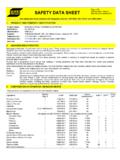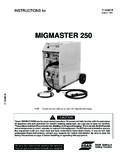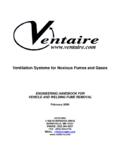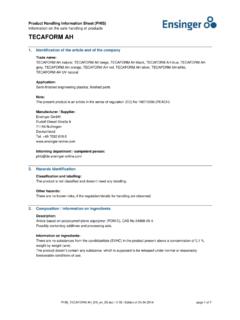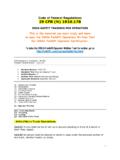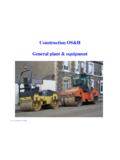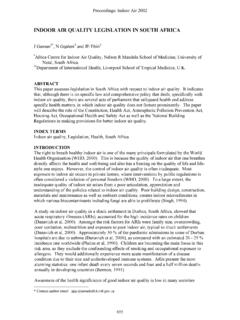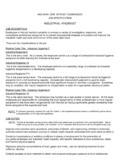Transcription of WARNING - ESAB Welding & Cutting
1 Precautions and Safe Practices forGAS Welding , Cutting , and HEATINGP rotect yourself and others. Read and understand this (17982) December, 2009 Keep this booklet available for reference at all times. You can get extra copies through your sure this information reaches the Welding & Cutting ProductsOXWELD / PUROX / PREST-O-LITE 2 FOREWORDThe Occupational Safety and Health Act of 1970 (OSHA) was enacted to as-sure safe and healthful working conditions for working men and . As duties under Section 5 of this Act, each employer shall:1. Furnish to each of his employees employment and a place of em-ployment which are free from recognized hazards that are caus-ing or are likely to cause death or serious physical harm to his Comply with occupational safety and health standards promul-gated under this employee shall comply with occupational safety and health standards and all rules, regulations, and orders issued pursuant to this Act which are applicable to his own actions and an employee has language difficulties or cannot be expected to read and under-stand this booklet, the employer should provide additional training and help to the booklet provides safety and health information on oxy-fuel gas Welding , Cutting , heating, and allied products and processes such as brazing, soldering, and use of air-fuel gas equipment.
2 You should be familiar with the information in this booklet as well as Safety in Welding and Cutting - ANSI , which is published by the American Welding Society, P. O. Box 351040, Miami, Florida, 33135. Material Safety Data Sheets (MSDS s) on various products, such as weld-ing rods, wires and fluxes, also provide helpful safety and health the manufacturers operating instructions for the apparatus you use. You should be familiar with the proper operation of all equipment before you start to work. ALWAYS READ AND UNDERSTAND THE MANUFACTURER S OPERATING INSTRUCTIONS AND YOUR EMPLOYER S SAFETY PRACTICES BEFORE OPERAT-ING AND MAINTAINING GAS Welding AND Cutting READ AND UNDERSTAND ALL PRECAUTIONARY LABELS AND IN-STRUCTIONS BEFORE USING EQUIPMENT, MATERIALS, OR GASES. A typical pre-cautionary label (tag) for Welding materials is shown on Page 3. This booklet provides supplementary precautionary : Protect yourself and others.
3 Read and understand this AND GASES can harm your health. HEAT RAYS (INFRARED RADIATION from the flame or hot metal) can Injure eyes. NOISE can damage hearing. Read and understand the manufacturers instructions end your employer s safety practices. Keep your heed out of the fumes. Do not breathe fumes and gases caused by the flame. Use enough ventilation . The type and amount of fumes and gases depend on the equipment and supplies used. Air samples can be used to find out what respiratory protection is needed. Wear correct ear, eye, and body protection. Prevent fires. Send equipment In need of repair to maintain UL listing. To learn more about SAFETY AND HEALTH read the manufacturers literature; form 2035 Pre-cautions and Safe Practices for Gas Welding , Cutting , and Heating ; OSHA Title 29 CFR 1910 from the Govt Printing Office; and American National Standard , Safety In Welding and Cutting available from the American Welding Society, Box 351040, Miami, FL AID: IN CASE OF EMERGENCY - Call for medical aid.
4 Employ First Aid techniques recommend-ed by the American Red Cross. IF BREATHING IS DIFFICULT give oxygen. Calla physician. IN CASE OF EYE BURN call a Removed, Save This sure it is read by all users of this INDUSTRY USE ONLYThis booklet is intended for beginners and skilled operators. The Appendix, which discusses the health hazards, is intended for use by persons trained in first aid, as well as medical profession-als. It will help you do the best job possible. Additional copies of this booklet (2035) may be obtained from your Sales Representa-tive or safety and health information covering arc Welding and cut-ting operations, obtain a copy of Form 52-529, Precautions and Safe Practices for Arc Welding , Cutting and Gouging. IMPORTANT SAFETY MESSAGE This Box Contains An Oxygen RegulatorThat Was Specially Designed For Burnout Containment. Ask Us About It. PREVENT SERIOUS INJURYThis label is placed on all boxes containing oxygen Page 22 for important.
5 2 DESCRIPTION OF MAJOR HAZARDS AND PRECAUTIONS ..5 fumes and gases ..5 Heat Rays and ..8 Prevent Fires ..9 Welding and Cutting of Containers ..10 Oxygen ..10 Fuel Gases ..11 Handling, Storage, and Use of Cylinders ..12 Manifolded Cylinders and Piping Systems ..17 Setting Up and Operating Oxy-Fuel Gas Systems ..18 Cylinders and Equipment ..18 Oxygen Regulators ..22 Confined Spaces ..23 Other Recommended Safe Practices ..24 MAINTENANCE PRECAUTIONS ..26 APPENDIX ..281. Chemical Substances and Potential Health Hazards in the Welding and Cutting Environment ..28 RECOMMENDED REFERENCES ..37 EMERGENCY AND FIRST AID PROCEDURES ..Back CoverESAB Welding & Cutting Box 100545 Florence, SC 29501-0545(803) 669-4411 DISTRIBUTORS IN PRINCIPAL CITIESThe terms Oxweld , Purox , and Prest-O-Lite areregistered trademarks of ESAB Welding & Cutting ProductsCopyright 1994 by ESAB Welding & Cutting ProductsTABLE OF CONTENTS5 fumes and gases can harm your your head out of the fumes.
6 Do not breathe fumes and gases caused by the flame. Use proper ventilation . The type and the amount of fumes and gases depend on the type of materials, equipment and supplies used. Air samples can be used to find out what respiratory protection is Provide enough ventilation wherever gas Welding , Cutting , and heating operations are performed. Proper ventilation will protect the operator from the evolving noxious fumes and gases . The degree and type of venti-lation needed will depend on the specific operation. It varies with the size of work area, on the number of operators, and on the types of materials used. Potentially hazardous materials may exist in certain fluxes, coatings, and filler metals. They can be released into the atmosphere during heat-ing, such as for Welding and Cutting . In some cases, general natural-draft ventilation may be adequate. Other operations may require forced-draft ventilation , local exhaust hoods, booths, personal filter respirators or air-supplied masks.
7 Operations inside tanks, boilers, or other confined spaces require special procedures, such as the use of an air supplied hood or hose NOT BREATHE fumes and gases CAUSED BY THE YOUR HEAD OUT OF PROPER OF MAJOR HAZARDS AND PRECAUTIONS61. Check the atmosphere in the work area and ventilation system if workers develop unusual symptoms or complaints. Measurements may be needed to determine whether adequate ventilation is being provided. A qualified person, such as an industrial hygienist, should survey the operations and environment. Follow their recommendations for improving the ventilation of the work Do not weld, cut, or heat dirty plate or plate contaminated with unknown material. The fumes and gases which are formed could be hazardous to your health. Remove all paint and galvanized coatings before beginning. All fumes and gases should be considered as potentially information on various fumes and gases that can harm your health is located in the Appendix of this booklet.
8 Material Safety Data Sheets also provide helpful safety and health information. More complete information on health protection and ventilation recommendations for general Welding and Cutting can be found in the American National Standard , Safety in Weld-ing and Cutting .TYPICAL METHODS FOR VENTILATIONAND RESPIRATORY PROTECTIONFORCED DRAFT ventilation BOOTHS LOCAL EXHAUST HOODS AIR SUPPLIED MASK 7 HEAT RAYS (INFRARED RADIATION from the flame or hot met-al) and SPATTER can injure eyes and burn correct eye, ear, and body and hot metal emit infrared rays. Operators may receive eye and skin burns after over exposure to infrared rays. Long overexposures may cause a severe eye burn. Hot Welding spatter can cause painful skin burns and perma-nent eye be sure you are fully protected from the infrared radiation and spatter, fol-low these precautions:1. Wear safety goggles made for gas Welding and Cutting purposes.
9 They will protect your eyes from radiation burns and from sparks or spatter. Use the correct lens shade to prevent eye injury. Choose the correct shade from the table below. Observers should also use proper RECOMMENDATIONS (adapted from ANSI Safety Standard ) Application Lens Shade No.*Brazing ..3 or 4 Light Cutting [to 1-in ..3 or 4 Medium Cutting [1 to 6-in.] ..4 or 5 Heavy Cutting [over 6-in.] ..5 or 6 Light Welding [to 1/8-in.] ..4 or 5 Medium Welding [1/8 to 1/2-in.] ..5 or 6 Heavy Welding [over 1/2-in.] ..6 or 8*As a rule of thumb, start with a shade that is too dark to see the work zone. Then go to a lighter shade which gives sufficient view of the work zone without exerting a strain on your Protect against eye injury, mechanical injury, or other mishaps. Wear safety glasses with side shields when you are in any work Wear clean, fire-resistant, protective clothing. Some operations produce sparks and spatter.]
10 Protect all skin areas from sparks or spatter. Avoid spark and spatter traps by wearing a jacket with no pockets, and pants with no cuffs. Sleeves should be rolled down and buttoned. Collars should be but-toned. Wear high, snug fitting safety shoes and gauntlet gloves. Protect your head by wearing a leather cap or hard hat. Wear ear protection where there is a chance of sparks or spatter entering your ears. Do not wear cloth-ing stained with grease and oil. It may burn if ignited by the flames or sparks and spatter. For high heat work, such as heavy Cutting , scarfing, or oxygen lance operations, face shields, fire-resistance aprons, leggings, or high boots may be needed. Remove all flammable and readily combus-tible materials from your pockets, such as matches and cigarette CLOTHING TO PROVIDE MAXIMUM PROTECTION FROM SPARKS AND HOT METAL4. Protect neighboring workers. Shield your station with metal or heat resis-tant can damage correct ear ear protective devices or earplugs when heavy Cutting , scarfing, or oxy-gen lancing is being performed, or in noisy work areas.
